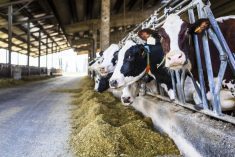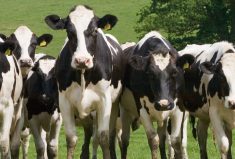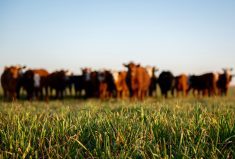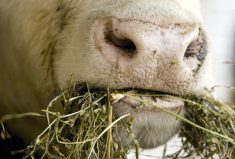“…if you drain that wetland and convert it into cropland, you’re just exchanging that methane problem for a nitrous oxide problem.”
– PASCAL BADIOU
Tackling the threat of global climate change is tough enough; it’s harder still when you aren’t even sure of the culprits.
For example, cattle emit methane, but good grazing management practices sequester carbon, and many argue the good they do outweighs the bad.
Wetlands, too, emit swamp gas, which is just another name for methane, one of the three leading gases blamed for contributing to the greenhouse effect.
Read Also

Pig transport stress costs pork sector
Popular livestock trailer designs also increase pig stress during transportation, hitting at meat quality, animal welfare and farm profit, Agriculture and Agri-Food Canada researcher says
Methane is 15 times more potent than carbon dioxide in trapping radiant heat from the sun inside the big blue dome of the sky.
Cattle and sheep are being fingered as a major source of methane emissions, and there’s a movement calling for “meatless Mondays” to save the planet.
Tofu pushers, notably former Beatle-turned-vegetarian-activist Sir Paul McCartney, are calling for a 15 per cent reduction in meat consumption worldwide, driven by the thinking that less livestock will reduce emissions of the climate-altering gas.
NO SIMPLE ANSWERS
In the stampede for solutions, the simple answer would be to remove both cattle and wetlands from the picture, right?
Not so fast, according to Pascal Badiou, a researcher with Ducks Unlimited Canada.
“The work that we’ve conducted on restored Prairie wetlands and intact wetlands and grasslands, indicates that even after accounting for the methane emissions, they are still acting as significant carbon sinks,” said Badiou, on the sidelines of a Manitoba Soil Science Society summer tour stop at the MZTRA research farm north of Brandon.
Proof could be seen in a “katina” trench that was dug from a high spot in a cultivated field down to a small wetland. It showed how the layer of black topsoil – rich in sequestered carbon – gradually widened from a thin band to almost pure-black muck.
ANAEROBIC
That’s no surprise, said Badiou. Research has shown that wetlands, due to their slow, anaerobic process for decomposing plant material, store significantly more organic carbon than adjacent uplands.
Apart from providing a valuable niche for countless species large and small, and improving overall water quality, wetlands are arguably the most important component of the terrestrial carbon cycle. Although they do emit methane, he added, at least it’s a natural source.
“They are responsible for the largest conversion of carbon on the landscape,” said Badiou.
“There are some wetlands that do produce a lot of methane; there’s no way around it. But the issue is, if you drain that wetland and convert it into cropland, you’re just exchanging that methane problem for a nitrous oxide problem.”
Everyone loves ducks, wildlife and wetlands, while cowboys and their cattle are an easier target.
SWAMPED
But activists may be missing an important link between the two. Anyone who has ever witnessed the spectacle of a massive, four-wheel-drive tractor mired in a bog knows that four legs get along better with swamps than four wheels.
Draining a wetland for cropping purposes results in the loss to the atmosphere of anywhere from 50 to 100 tonnes of organic carbon per hectare, he said, and the creation of a nitrous oxide “hot spot.”
Using that metric, and given the history of agriculture on the Prairies, the draining of swamps over the past century has resulted in a massive release of greenhouse gases into the atmosphere.
According to the Envi ronmental Protect ion Agency in the United States, if carbon dioxide represents one unit of global warming potential, then one unit of nitrous oxide is as dangerous to climate stability as 310 units of C02.
Tofu eaters may not realize that because their protein source is made from soybeans, it may have been grown on a former wetland, or possibly a vast monoculture farm in South America.
So why the confusion among those advocating solutions to global climate change?
“It’s a little tricky. This research on wetlands has only gotten underway over the last decade,” said Badiou. “The science is fairly new.”
MORE COMPLICATED
As they dig deeper into the question, researchers are finding that the real picture is more complicated than they once thought.
For example, the rate of methane emissions from wetlands varies depending on the time of day, and peaks in the afternoon. If researchers only check the concentration of the gas in their collectors at that time, a misleading bias pointing towards high methane emissions from wetlands could result, he added.
Furthermore, shallow Prairie wetlands are frozen several feet down for a good portion of the year. When the thaw comes in May or June, a “spring burp” of methane in the testing apparatus may make them look like worse emitters than they actually are.
Also, the focus of most research is on organic carbon. But Prairie wetlands have sky-high pH levels– in some cases as high as eight or nine – mainly due to the high calcium carbonate levels in the surrounding soil.
“What that means is that there is an awful lot of biologically mediated calcium carbonate precipitation,” he said.
“So, essentially, it’s carbon sequestration but in an inorganic form. In the future, we hope to try to account for that because currently we’re underestimating the amount of carbon sequestration in a wetland by only focusing on the organic carbon fraction.” [email protected]










![“The thought behind [this study] is that perhaps not every individual in the herd will need to be fed a feed supplement to reduce methane emissions.” – Katie Wood, University of Guelph.](https://static.manitobacooperator.ca/wp-content/uploads/2023/11/16113900/cattle-calves-pasture2-lrance_cmyk-6-220x165.jpg)







